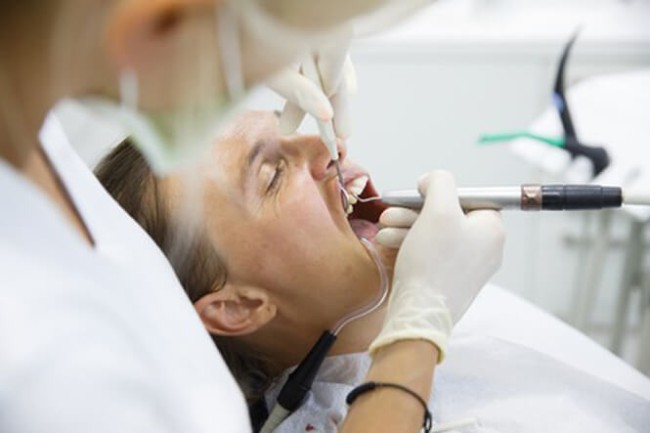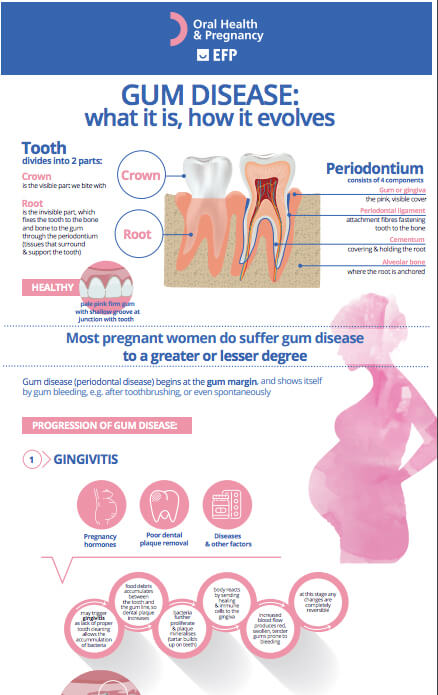Wishing everyone happy holidays and a joyful New Year from the Healthify team. Don't forget to Slip, Slop, Slap and Wrap!
Gum disease
Also known as periodontal disease or periodontitis
Key points about gum disease
- Gum disease is also known as periodontal disease or periodontitis.
- It's caused by an infection that destroys the bone surrounding and supporting your teeth.
- It's a serious condition and if you have the symptoms (loose teeth, bad breath, gum tenderness, receding gums or gaps opening up) you should see your dentist.

Gum disease (periodontitis) is caused by bacteria that destroys the bone surrounding and supporting your teeth.
Symptoms include:
- loose teeth
- bad breath
- gum tenderness
- receding gums
- pus in your gums
- gaps opening up in your teeth.
Periodontitis usually builds up slowly over many years but some people may have a very active form of the disease that causes rapid loosening and loss of the teeth.
It’s a serious condition and if you have the symptoms you should see your dentist. You can’t treat periodontitis at home, but a dental professional can treat it with scaling, root planing and other treatments.

Image credit: 123RF
Your mouth is full of bacteria. These bacteria, along with mucus and other particles, constantly form a sticky ‘plaque’ on your teeth. If you don’t brush and floss regularly, the plaque can harden and form ‘tartar’ (also known as ‘calculus’). Calculus increases the rate at which plaque forms, as it provides a surface for the bacteria to collect on.
While your body's immune system is working to get rid of the toxins created by bacteria, it can accidentally damage your gum tissues. This leads to your gums pulling away from your teeth and forming spaces, called pockets, that become infected. These pockets are filled with bacteria and can be hard to clean.
If not treated, this can lead to the bone and connective tissue that hold your teeth in place breaking down. The bones, gums and tissue that support your teeth can be destroyed. Your teeth may eventually become loose and have to be removed.
Gingivitis is a milder inflammation of your gums. It's also caused by the bacteria in your mouth forming plaque on your teeth. However, if you improve your oral hygiene habits, you can usually get rid of gingivitis at home. If you don’t, gingivitis may turn into periodontitis, but not always.
Periodontitis is more severe inflammation and infection leading to loss of tooth support, including loss of bone and gum tissue. You may have gingivitis before developing periodontitis, but not always. You are more likely to get periodontitis if you smoke or have diabetes, and have poor oral hygiene.
Periodontitis may develop without the symptoms of gingivitis. If you're a smoker or have a suppressed immune system, you may not get bleeding gums as other people would.
Our mouths have thousands of different bacteria, some thought of as healthy, some considered bad for us. When we have bad bacteria growing successfully deep down in pockets, we can't get rid of them with home care. We need the pockets to be cleared out thoroughly by a periodontist to try to eliminate the bad bacteria and allow healing.
Signs of periodontal/gum disease include:
- teeth getting loose by themselves
- bad breath (halitosis)
- tenderness in your gums
- gum recession – seeing more of the root or neck of the tooth
- pus between your teeth
- gaps opening up between your teeth
- teeth becoming sensitive to temperature and sore to chew on.
You're more likely to develop periodontitis if you have one or more of the following risk factors.
Smoking
Smoking is one of the biggest risk factors associated with the development of gum disease. This is because when bacteria attack your gums, the lower immune response and poor blood supply as a result of smoking mean your gums don’t fight back against the bacterial infection. If you smoke, it also lowers your chance of treatment working to improve your gum disease. If you stop smoking, your gums will start to attack the plaque caused by the bacteria, which means you will get the symptoms that have been suppressed by smoking, such as bleeding gums.
Diabetes
People with diabetes are at higher risk for developing infections, including gum disease. This is because diabetes causes your blood vessels to thicken, preventing the successful flow of repair cells and blood to the areas that usually keep your gums in good health.
Pregnancy
The hormonal changes that occur during pregnancy can make your gums more reactive. This makes gums seem to over-react to plaque which makes inflammation and bleeding happen more easily than usual. Making even more effort with your home care usually reduces this.
Medicines
Prescription and over-the-counter medications can reduce the flow of saliva. Saliva helps protect your gums from bacteria. If your mouth is dry, it becomes more vulnerable to infections such as gum disease.
Some medicines can also cause abnormal overgrowth of your gum tissue, making it difficult to keep teeth and gums clean.
Existing oral conditions
Having calculus/tartar, poorly shaped large fillings or badly fitting partial dentures increases your risk of gum disease developing. This is because they provide sites for bacteria to build up undisturbed, which can then form more plaque.
Other health conditions
Treatments for HIV/AIDS and cancer can affect your immune system and therefore can negatively affect the health of your gums as repair cells are not working effectively.
Genes
Some people are more likely to develop severe gum disease than others and this can run in families. However, looking after your teeth and gums well at home can prevent this – it doesn't have to happen.
If you have any symptoms of periodontitis, see your dentist or dental hygienist.
At your dental visit the dentist or hygienist is likely to:
- ask about your medical history to identify underlying conditions or risk factors (such as smoking and diabetes) that may contribute to gum disease
- examine your gums and note any signs of inflammation
- use a tiny ruler called a ‘periodontal probe’ to check for and measure any pockets. In a healthy mouth, the depth of these pockets is usually less than 3 mm. This test for pocket depth is usually painless, but not always.
Other things your dentist or hygienist may do:
- Take an X-ray to see whether there's any bone loss and see how solid the bone surface under your gums seems to be.
- Refer you to a periodontist. Periodontists are experts in the diagnosis and treatment of gum disease and may provide you with treatment options that are not offered by your dentist. They have a dental degree and a further degree specialising in periodontology (gum health).
The diagnosis will include what type of periodontitis you have. There are 3 types of periodontitis:
- necrotizing periodontitis
- periodontitis as a manifestation (result) of systemic diseases
- periodontitis.
Necrotizing periodontitis
This type of periodontitis usually occurs in people with low immunity. The main symptom, in addition to the other periodontitis symptoms, is ulcers on your gums.
Periodontitis as a manifestation of systemic disease
This occurs when an immune disorder that's affecting your whole system also affects your gums, leading to disease.
Periodontitis
This diagnosis is used when the other 2 types don't apply. Your dentist will determine the stage and grade of your periodontitis to help work out what treatment plan to follow.
Any of the symptoms may be a sign of a serious problem, which should be checked by a dentist. The main goal of treatment is to control the bacteria and the infection. The number and types of treatment will vary, depending on the extent of the disease. With any treatment, you will need to keep up good daily oral care at home. If you smoke, your dentist may suggest you quit to improve the outcome of the treatment.
Scaling and root planing
As gum disease progresses, plaque forms below your gum line in the pockets that have formed. This is impossible for you to clean off by yourself. Instead, a dentist, periodontist, or dental hygienist can remove the plaque through a deep-cleaning method called scaling and root planing.
Scaling means scraping off the plaque from above and below your gum line. It is a deep clean of all the hard and soft deposits on your teeth. Root planing gets rid of rough spots on the tooth root where bacteria gather and helps remove bacteria that contribute to the disease.
Laser treatment
In some cases, a laser may be used to remove plaque and tartar. This procedure can result in less bleeding, swelling and discomfort.
Medication
Medicines may be used with treatment that includes scaling and root planing, but they can't always take the place of surgery. Depending on how far the disease has progressed, the dentist or periodontist may still suggest surgical treatment. Long-term studies are needed to find out if using medicines reduces the need for surgery and whether they're effective over a long period of time.
Talk to your dentist or periodontist about whether any mouthwashes, antibiotics or other medication would help in your case.
Flap surgery
Surgery might be necessary if inflammation and deep pockets remain following treatment with deep cleaning and medications.
This common surgery involves lifting back your gums and thoroughly removing the tartar. The gums are then stitiched back in place so that the tissue fits snugly around the tooth again. This makes it easier to keep the area clean. After surgery, the gums will heal and fit more tightly around the tooth. This sometimes results in the teeth appearing longer. While this sounds extreme, it can often be the best way to completely clear the pockets and clean the surfaces, with better healing in the long term.
- Follow good oral hygiene practices such as gentle regular brushing and cleaning between your teeth, and seeing your dentist at least once a year. Read about taking care of your teeth.
- Follow any special instructions from your dentist.
- If you smoke, quit, as this will improve your treatment outcomes and help prevent future gum disease developing.
- If you have gum recession, make sure you aren’t over-brushing (brushing too much or too hard), and that you're using a soft toothbrush. Read more about tooth wear.
- If you have diabetes, work hard to control this to promote good blood vessel health for your gums.
Apps reviewed by Healthify
You may find it useful to look at some Diabetes apps and Quit smoking apps.
The same good oral hygiene practices that protect your teeth also protect your gums from the bacteria build-up that leads to inflammation and infection.
This includes:
- brushing your teeth twice a day (first thing in the morning and before bed) with a fluoride toothpaste
- using a soft or ultra-soft toothbrush – medium and hard toothbrushes can damage your gums and can be less effective at removing plaque
- flossing once a day to remove plaque from between your teeth – if you have larger gaps between your teeth a dental professional might recommend you use an interdental brush
- visiting your dentist and dental hygienist regularly for a check-up and professional cleaning
- using an electric toothbrush rather than a manual one.
You should also:
- visit your dentist routinely for a check-up and professional cleaning
- be smokefree and limit alcohol intake
- avoid cannabis use as this is associated with severe gingivitis and periodontitis
- avoid eating sugary foods between meals.
Read more about taking care of your teeth
Avoiding smoking is a key step in keeping your gums healthy. If you smoke, you have a higher risk of gum problems (and oral cancer), such as complications after tooth extractions and surgery in your mouth. You have lower resistance to infections and your healing is impaired.
If you smoke, a gum condition may not be noticed because poor blood supply to your gums mean they don't bleed when they usually would. If you're a smoker and you stop smoking, your gums are likely to start to bleed. This is because the blood supply is returning to your gums and they are starting to fight the plaque.
It’s been found that people with gum disease were more likely to develop heart disease or have difficulty controlling blood glucose than people without gum disease. It's understood that bacteria from your mouth can get into your blood stream when gums are bleeding, then bacteria can settle on artery walls and cause blockages – especially in tiny arteries like the ones that make your heart pump well.
Other studies have showed that pregnant people with gum disease were more likely than those with healthy gums to deliver preterm, low birthweight babies. However, although it is clear that some people with gum disease may be at higher risk of developing these problems, it’s not yet understood exactly how gum diseases affect and sometimes cause them.
The following links provide further information about periodontitis or gum disease. Be aware that websites from other countries may have information that differs from New Zealand recommendations.
Dental plaque and gum disease(external link) Patient Info, UK
Gum disease(external link) NHS Choices, UK
Gingivitis and periodontal disease(external link) WebMD, US
Apps
Quit smoking apps
Diabetes apps
Resources
It's easy to protect your family's smile(external link) HealthEd, NZ
Available in the following languages: English(external link), Cook Islands Māori(external link), te reo Māori(external link), Niuean(external link), Samoan, Tokelauan(external link), Tongan(external link)
Take care of your teeth(external link) HealthEd, NZ
Gum disease – what it is, how it evolves(external link) Oral Health & Pregnancy, UK
References
- Dental plaque and gum disease(external link) Patient Info, UK, 2023
- Effects of smoking and vaping on oral health(external link) Better Health, Australia, 2021
- EL Morelli, JM Broadbent, JW Leichter, et al. Pregnancy, parity and periodontal disease(external link) Australian Dental Journal. 2018;0:1–9.
- Papapanou PN, Sanz M, et al. Periodontitis – consensus report of workgroup 2 of the 2017 World Workshop on the Classification of Periodontal and Peri‐Implant Diseases and Conditions(external link) Clin Periodontol. 2018;45(Suppl 20):S162–S170.
- Robinson P, Deacon S A, Deery C et al. Manual versus powered toothbrushing for oral health. (external link)Cochrane Database Syst Rev 2005; CD002281.
- Gum disease(external link) NHS Inform, UK, 2023
See also pages for clinicians on gum conditions and gingivitis
EL Morelli, JM Broadbent, JW Leichter, WM Thomson. Pregnancy, parity and periodontal disease(external link) Australian Dental Journal. 2018; 0: 1–9.Robinson P, Deacon S A, Deery C et al. manual versus powered toothbrushing for oral health (external link)Cochrane Database Syst Rev 2005; CD002281. some dental and periodontal diseases(external link) Patient Info Professional, UK, 2014
Chapple IEC, Mealey BL, et al. periodontal health and gingival diseases and conditions on an intact and a reduced periodontium.(external link) J Clin Periodontol. 2018 Jun;45 Suppl 20:S68-S77
Papapanou PN, Sanz M, et al. Periodontitis – consensus report of workgroup 2 of the 2017 world workshop on the classification of periodontal and peri‐implant diseases and conditions(external link) Clin Periodontol. 2018;45(Suppl 20):S162–S170.
Brochures

HealthEd, NZ, 2022
English, Cook Islands Māori, te reo Māori, Niuean, Samoan, Tokelauan, Tongan

Oral Health & Pregnancy, UK
Credits: Healthify editorial team. Healthify is brought to you by Health Navigator Charitable Trust.
Reviewed by: Sophie McKenna, General Dental Surgeon
Last reviewed:





